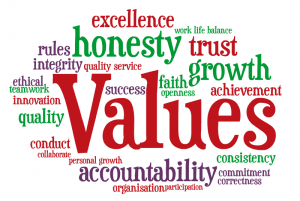Back in February, I wrote about the 4 Dimensional Leader Model I use to help leaders develop their self awareness and improve their inner game of leadership. Check it out here.
The 4 domains are Physical, Intellectual, Emotional and Spiritual. The Spiritual domain represents your moral compass. It defines who you are and how you identify yourself and behave in the world. In gaining a clearer awareness of who you are, you must understand the values and principles that guide your life and your leadership style. Your values help you define your moral center. Without a moral center, it is difficult, if not impossible to lead and act authentically.
Clarifying your values and identifying the principles and behaviors that translate your values into action is the center of the Spiritual domain.
What are your core values and guiding leadership principles that shape your leadership, your presence, and your decision making? If you are not clear; don’t feel bad. Many leaders I work with did not initially know what values defined them. In fact, I am often the first person to ask them about their values.
I recommend that you get going on defining your values and principles. I have outlined below a process I use to help leaders clarify what values are important to them. You can also start by reflecting back on your life to those persons who had the greatest impact on your life and what they taught you, what they expected from you, and what they demonstrated to you as to how you should lead your life. Typically, these are your parents, a teacher, coach or spiritual leader. Values are derived from the beliefs and convictions you learned from others.
Here is the process I use to help leaders get clear on those values, and the principles and behaviors that shape them as a person and leader.
First, get a deck of value cards. When working with leaders, I use the Values Deck from Margie Heiler. You can go to her website at www.roadtoresilience.com for more information and order the deck here.
Begin by becoming familiar with the cards and identify if the value is Important, Very Important or Most Important. I tell my leaders to think about the word on each card and what it means to them and then place the card under one of the above categories. When finished, take all the cards under the Most Important category and sort them again until you identify a list of your top 10 values that are the most important in your life and your leadership. Then:
- Rank them in order of importance from top to bottom.
- Add a list of defining words or descriptors that communicates what each value means to you. Then fully define each value. What do they mean to you?
- Define a set of principles which translates your values to action. These are a set of standards and habits that make your values noticeable to you and others. How will you and others know that you are demonstrating this value?
- Label each value according to how fully you are able to meet/express that value in your current job or life: Green for Fully Express; Yellow for Partially Meet; and Red for Not at All.
- Take notice where your top 3 values are labeled.
- Take action where needed.
Take your time with this process. It is a great time to do some self reflection and think deeper about how your values align with who you are as a person and leader. Share your results with someone you trust and who really knows you and can give you honest feedback.
Becoming a great and consistently effective leader starts by knowing who you are. Values help to define who you are!

